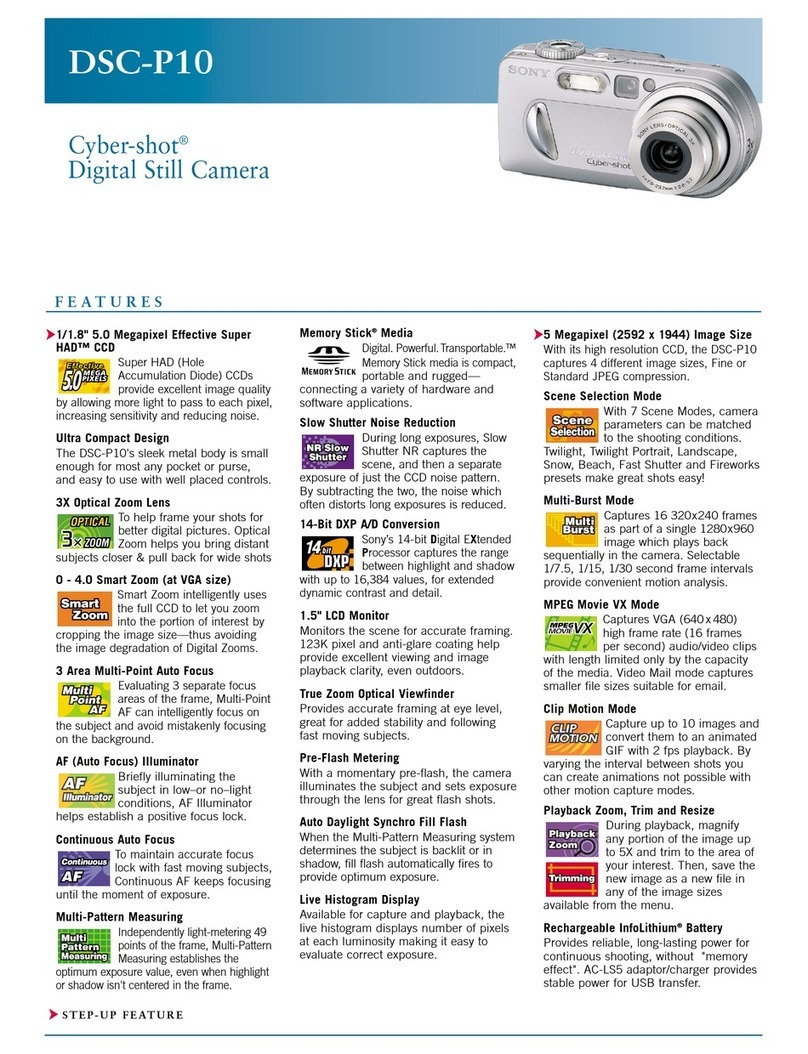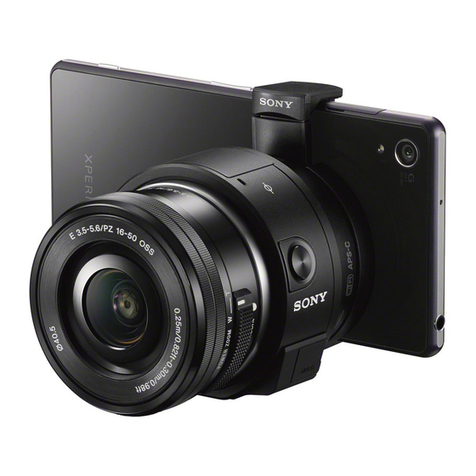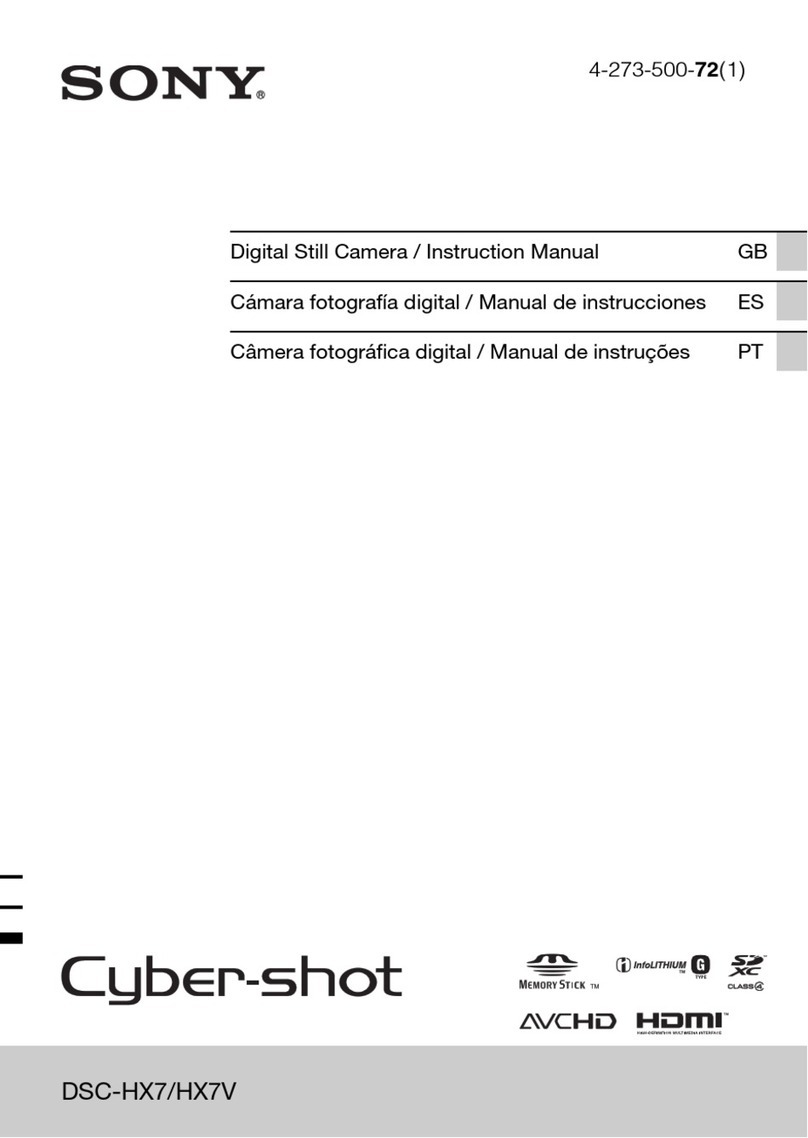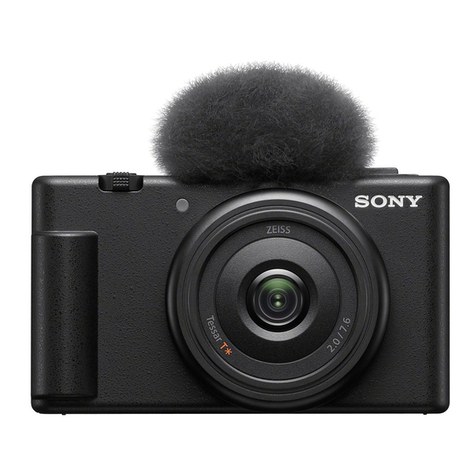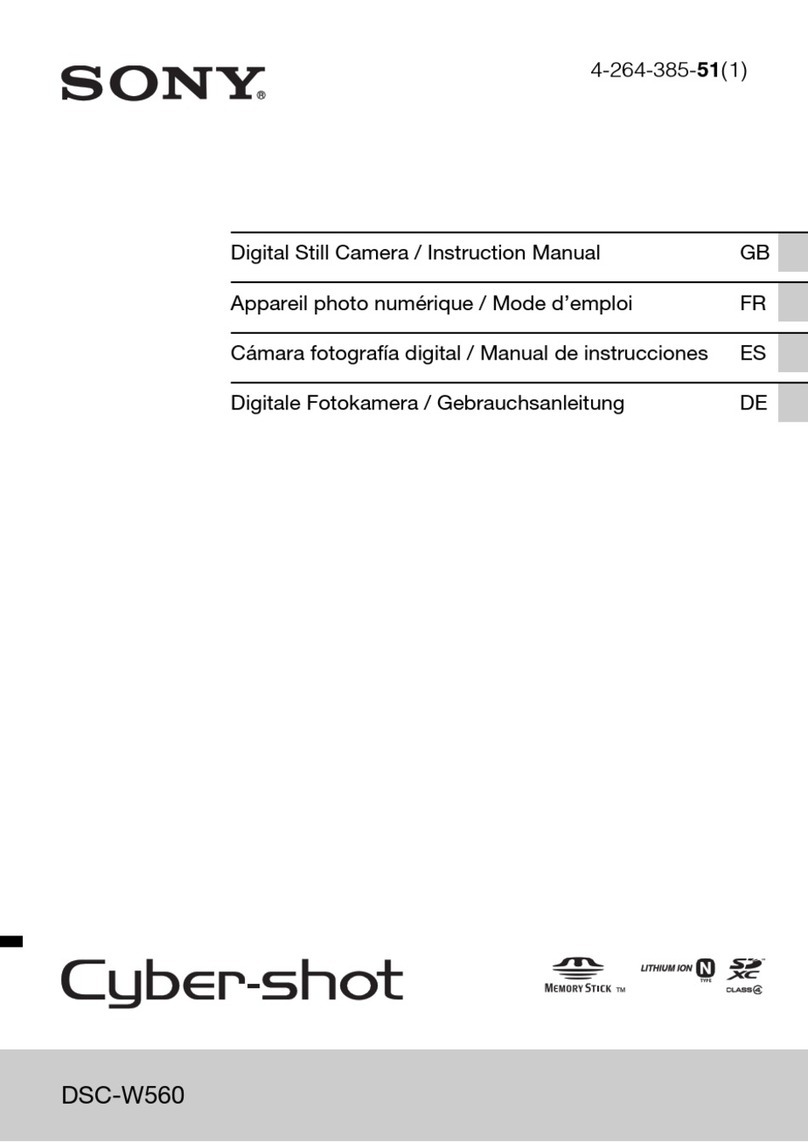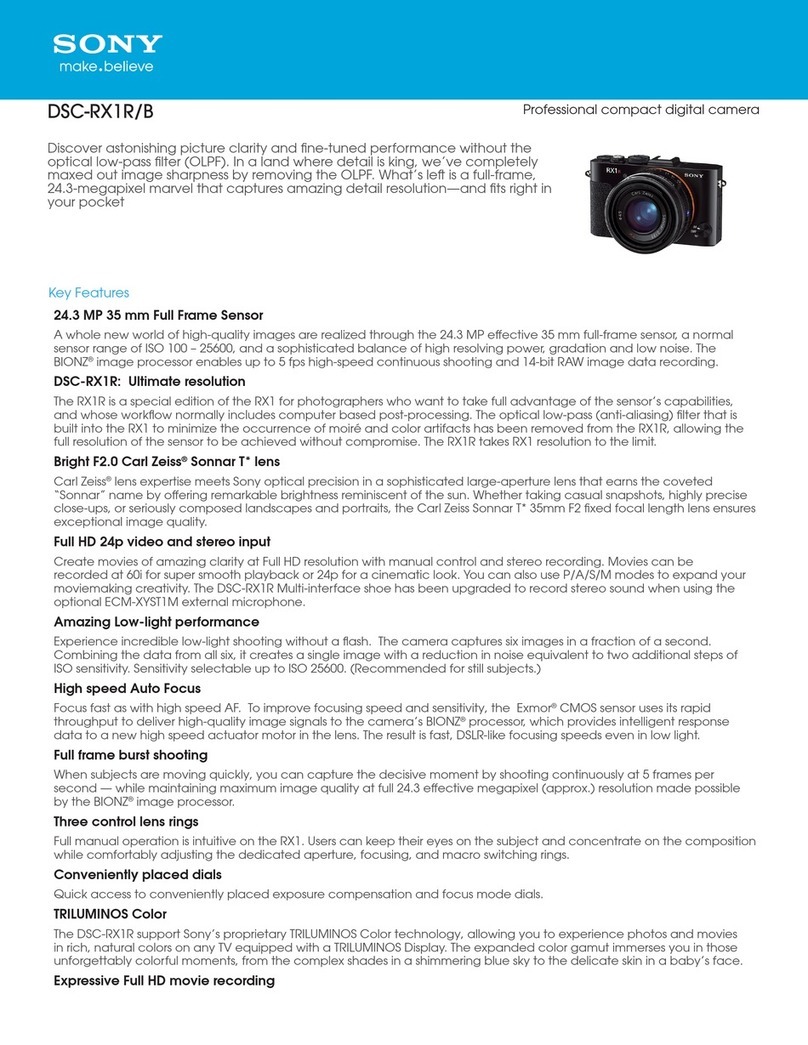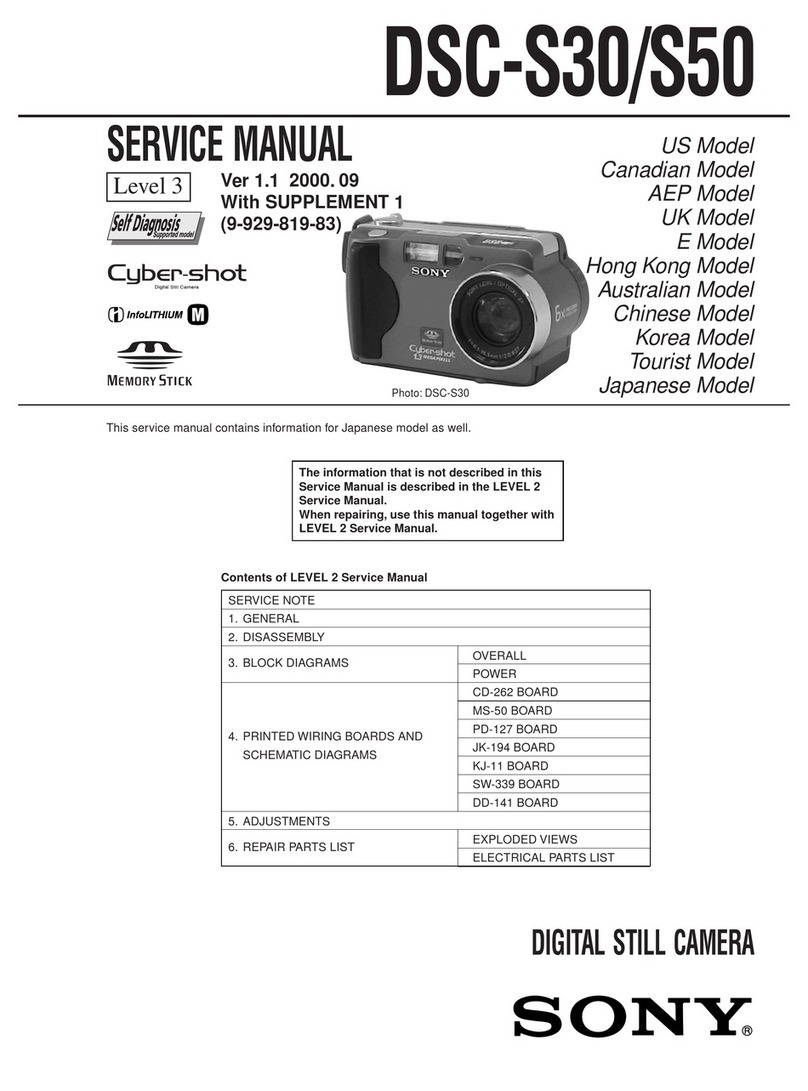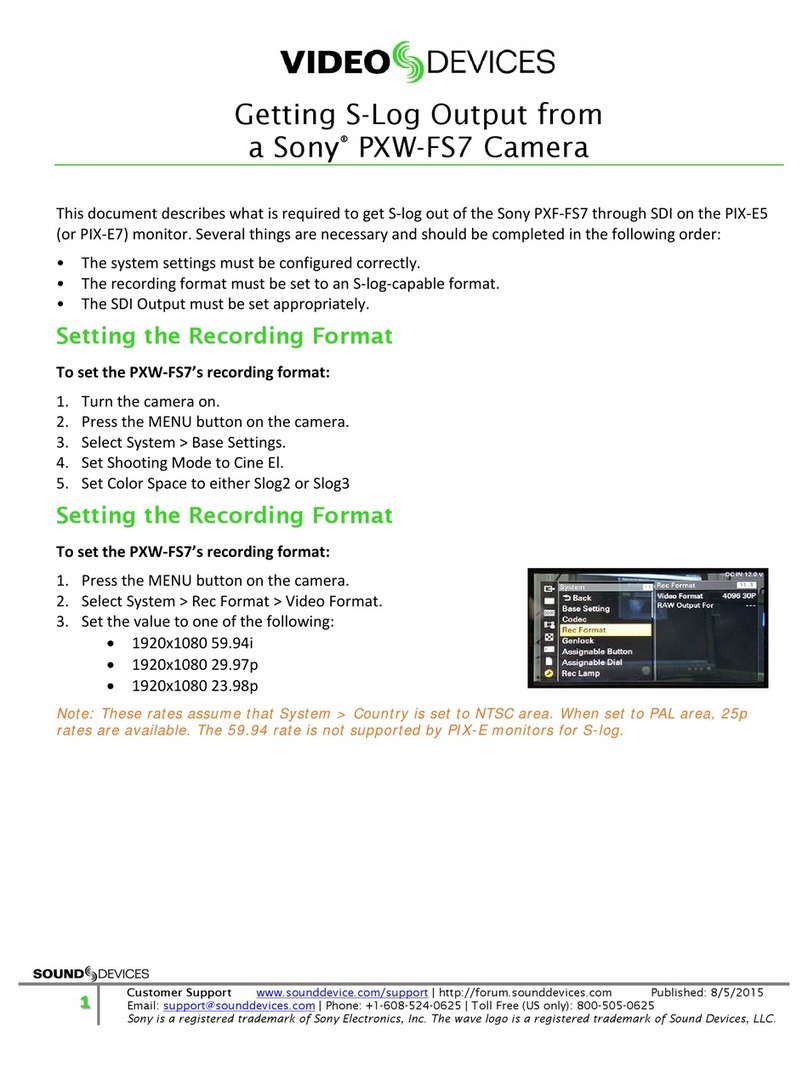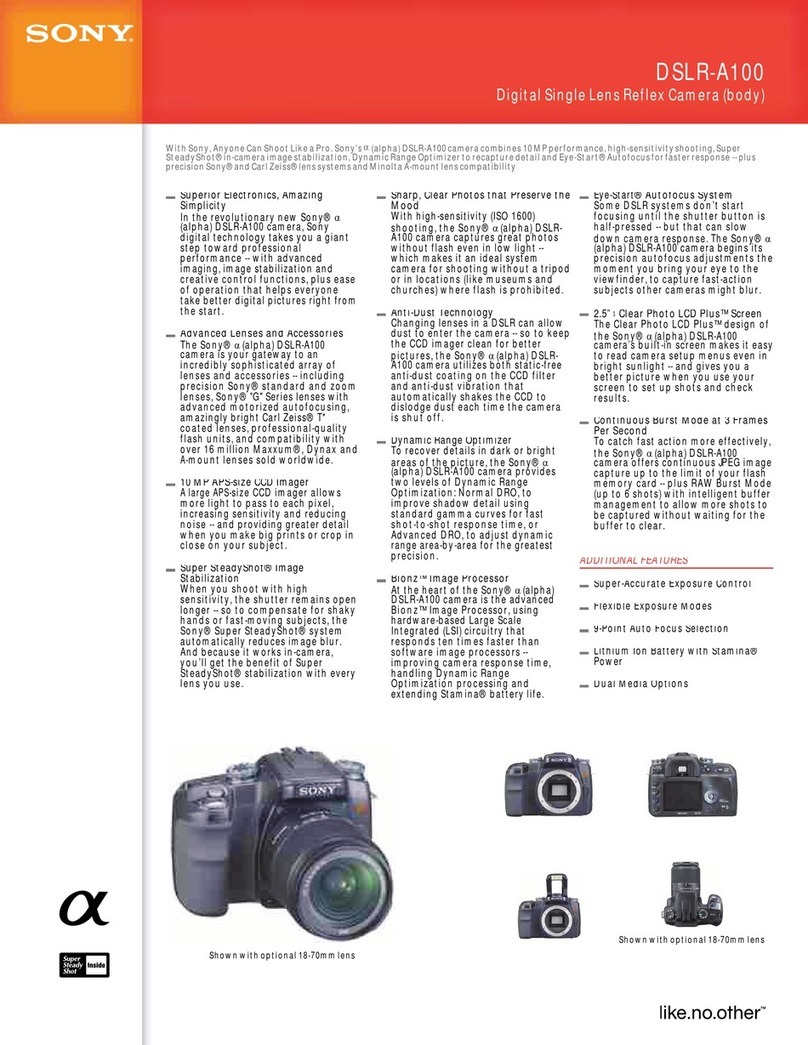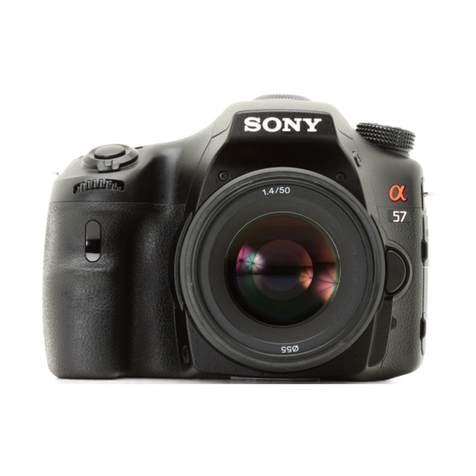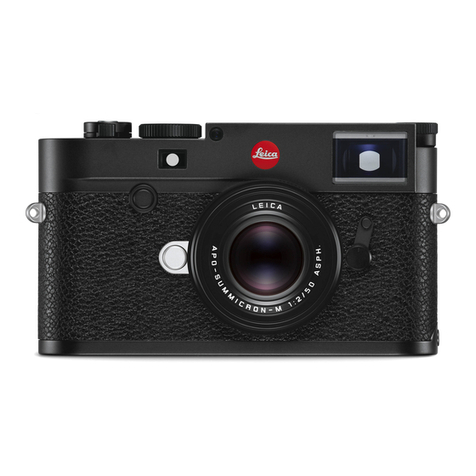
DSC-HX300_L2
– 2 –
SPECIFICATIONS 概略仕様
– ENGLISH – – JAPANESE –
Camera
[System]
Image device: 7.82 mm (1/2.3 type)
Exmor R CMOS sensor
Total pixel number of camera:
Approx. 21.1 Megapixels
Effective pixel number of camera:
Approx. 20.4 Megapixels
Lens: Carl Zeiss Vario-Sonnar T* 50×
zoom lens
f = 4.3 mm – 215 mm (24 mm –
1 200 mm (35 mm film equivalent))
F2.8 (W) – F6.3 (T)
While shooting movies (16:9):
26.5 mm – 1 325 mm*
While shooting movies (4:3):
32.5 mm – 1 625 mm*
* When [Movie SteadyShot] is set
to [Standard]
SteadyShot: Optical
Exposure control: Automatic exposure,
Shutter speed priority, Aperture
priority, Manual exposure, Scene
Selection
White balance: Automatic, Daylight,
Cloudy, Fluorescent 1/2/3,
Incandescent, Flash, One Push,
White Balance Shift
File format:
Still images: JPEG (DCF, Exif,
MPF Baseline) compliant, DPOF
compatible
3D still images: MPO (MPF
Extended (Disparity Image))
compliant
Movies (AVCHD format):
AVCHD format Ver.2.0
compatible
Video: MPEG-4 AVC/H.264
Audio: Dolby Digital 2ch,
equipped with Dolby Digital Stereo
Creator
• Manufactured under license from Dolby
Laboratories.
Movies (MP4 format):
Video: MPEG-4 AVC/H.264
Audio: MPEG-4 AAC-LC 2ch
Recording media: Internal Memory
(Approx. 48 MB), “Memory Stick
Duo” media, “Memory Stick
Micro” media, SD cards, microSD
memory cards
Flash: Flash range (ISO sensitivity
(Recommended Exposure Index)
set to Auto):
Approx. 0.5 m to 8.5 m
(1 ft. 7 3/4 inches to 27 ft.
10 3/4 inches) (W)/
Approx. 2.4 m to 3.5 m
(7 ft. 10 1/2 inches to 11 ft.
5 7/8 inches) (T)
[Input and Output connectors]
HDMI connector: HDMI micro jack
Multi/Micro USB Terminal*:
USB communication
USB communication: Hi-Speed USB
(USB 2.0)
* Supports Micro USB compatible device.
[Screen]
LCD screen: 7.5 cm (3.0 type) TFT
drive
Total number of dots: 921 600 dots
[Power, general]
Power: Rechargeable battery pack
NP-BX1, 3.6 V
AC Adaptor AC-UB10/UB10B/
UB10C/UB10D, 5 V
Power consumption:
Approx. 1.3 W (during shooting
with the LCD screen)
Approx. 1.1 W (during shooting
with the viewfinder)
Operating temperature: 0 °C to 40 °C
(32 °F to 104 °F)
Storage temperature: –20 °C to +60 °C
(–4 °F to +140 °F)
Dimensions (CIPA compliant):
129.6 mm × 93.2 mm × 103.2 mm
(5 1/8 inches × 3 3/4 inches ×
4 1/8 inches) (W/H/D)
Mass (CIPA compliant) (including NP-
BX1 battery pack, “Memory Stick
Duo” media):
Approx. 650 g (1 lb 6.9 oz)
Microphone: Stereo
Speaker: Monaural
Exif Print: Compatible
PRINT Image Matching III:
Compatible
AC Adaptor AC-UB10/UB10B/
UB10C/UB10D
Power requirements: AC 100 V to
240 V, 50 Hz/60 Hz, 70 mA
Output voltage: DC 5 V, 0.5 A
Operating temperature: 0 °C to 40 °C
(32 °F to 104 °F)
Storage temperature: –20 °C to +60 °C
(–4 °F to +140 °F)
Dimensions:
Approx. 50 mm × 22 mm × 54 mm
(2 inches × 7/8 inches × 2 1/4 inches)
(W/H/D)
Mass:
For the USA and Canada: Approx.
48 g (1.7 oz)
For countries or regions other than
the USA and Canada: Approx. 43 g
(1.5 oz)
Rechargeable battery pack
NP-BX1
Used battery: Lithium-ion battery
Maximum voltage: DC 4.2 V
Nominal voltage: DC 3.6 V
Maximum charge voltage: DC 4.2 V
Maximum charge current: 1.89 A
Capacity: 4.5 Wh (1 240 mAh)
Design and specifications are subject to
change without notice.
本体
[システム]
撮像素子:7.82 mm(1/2.3型)
Exmor R CMOSセンサー
総画素数:約2110万画素
カメラ有効画素数:約2040万画素
レンズ:カールツァイス バリオ・ゾナー
T
*50倍ズームレンズ
f=4.3 mm 〜215 mm
(24 mm 〜1 200 mm(35 mm
フィルム換算値))、F2.8(W)〜 F6.3(T)
動画撮影時(16:9):26.5 mm 〜1 325 mm*
動画撮影時(4:3):32.5 mm 〜1 625 mm*
*[動画手ブレ補正]が[スタンダード]のとき
手ブレ補正:光学式
露出制御:自動、シャッタースピード優先、
絞り優先、マニュアル露出、
シーンセレクション
ホワイトバランス:オート、太陽光、曇天、
蛍光灯1/2/3、電球、フラッシュ、
ワンプッシュ、ホワイトバランスシフト
記録方式:
静止画記録方式:
JPEG(DCF、Exif、MPF Baseline)準拠、
DPOF対応
3D静止画記録方式:MPO
(MPF Extended(立体視))準拠
動画記録方式(AVCHD方式):
AVCHD規格 Ver.2.0準拠
映像:MPEG-4 AVC/H.264
音声:Dolby Digital 2ch
ドルビーデジタルステレオクリエーター搭載
•ドルビーラボラトリーズからの実施権に基づき製
造されています。
動画記録方式(MP4方式):
映像:MPEG-4 AVC/H.264
音声:MPEG-4 AAC-LC 2ch
記録メディア:内蔵メモリー 約48MB、
メモリースティック デュオ、
メモリースティック マイクロ、
SDカード、microSDメモリーカード
フラッシュ:撮影範囲(ISO感度
(推奨露光指数)がオートのとき)
約0.5 m〜 8.5 m(W)/
約2.4 m〜 3.5 m(T)
[入出力端子]
HDMI端子:HDMIマイクロ端子
マルチ/マイクロUSB端子*:USB通信
USB通信:Hi-Speed USB(USB 2.0)
*この商品にはマイクロUSB規格に対応した機器をつ
なぐことができます。
[モニター]
液晶モニター:
7.5 cm(3.0型)、TFT駆動
総ドット数:921 600ドット
[電源・その他]
電源:リチャージャブルバッテリー
パックNP-BX1、3.6 V
ACアダプター AC-UB10/UB10B/
UB10C/UB10D、5 V
消費電力:約1.3 W(液晶モニターで撮影時):
1.1W(ファインダーで撮影時)
動作温度:0 ℃〜 40 ℃
保存温度:−20 ℃〜 +60 ℃
外形寸法(CIPA準拠):
129.6 mm×93.2 mm×103.2 mm
(幅×高さ×奥行き)
本体質量(CIPA準拠)(バッテリー
NP-BX1、
メモリースティック デュオを含む):
約650 g
マイクロホン:ステレオ
スピーカー:モノラル
Exif Print:対応
PRINT Image Matching III:対応
ACアダプター
AC-UB10/UB10B/UB10C/
UB10D
定格入力:AC 100 V 〜240 V、
50 Hz/60 Hz、70 mA
定格出力:DC 5 V、0.5 A
動作温度:0 ℃〜 40 ℃
保存温度:−20 ℃〜 +60 ℃
外形寸法:約50 mm×22 mm×54 mm
(幅×高さ×奥行き)
本体質量:約48 g
リチャージャブルバッテリーパック
NP-BX1
使用電池:リチウムイオン蓄電池
最大電圧:DC 4.2 V
公称電圧:DC 3.6 V
容量:4.5 Wh(1 240 mAh)
本機や付属品の仕様および外観は、改良のため予告
なく変更することがありますが、ご了承ください。
Model information table
Model DSC-HX300
Destination US, CND, E, KR, BR, J AEP, UK, RU, E, AUS, HK, CH, JE
Color system NTSC PAL
GPS – –
• Abbreviation
AUS : Australian model
BR : Brazilian model
CH : Chinese model
CND : Canadian model
HK : Hong Kong model
J : Japanese model
JE : Tourist model
KR : Korea model
RU : Russian model
